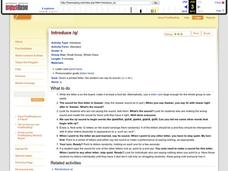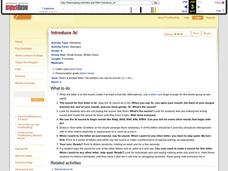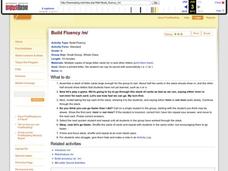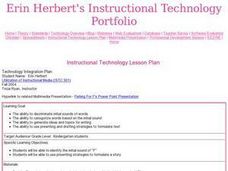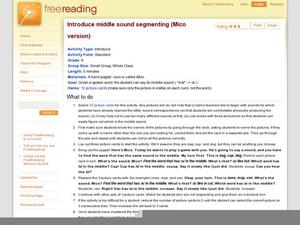Curated OER
Introduce /Q/
Everything your pre-readers need to know about the letter Q is right here; this strategy combines pronunciation, letter recognition, sound, and word examples. Scholars examine the letter shape and listen to you pronounce the /kwww/...
Curated OER
Phonemic Awareness: Blending
First graders listen closely as their teacher sounds out a variety of words, one phoneme at a time. They then practice blending sounds to create words on their own. Tip: While you sound out words have your class write down each phoneme...
Curated OER
Introduce /t/
What sound does the letter t make? As scholars develop letter recognition, form sound associations with strategies like these. Explain the tongue movement in making the /t/ sound, asking learners to try it. Draw the t on the...
Curated OER
Introduce /r/
Use these inventive strategies to focus on the letter r, forming sound associations along with letter recognition. Explain the tongue movement in making the /r/ sound, asking learners to try it. Draw the r on the board and give...
Curated OER
Introduce Soft-C
Do your emerging readers know that letters sometimes borrow the sounds of other letters? Explore the soft /c/ sound, explaining that c has borrowed the sound from s. After giving scholars some examples of words that begin...
Curated OER
Introduce /k/
Explore the ins and outs of the letter k using these strategies combining pronunciation, letter recognition, and initial phoneme examples. Scholars examine the letter shape and listen to you pronounce the /k/ sound. Use these tips to...
Curated OER
Beginning and Ending Sounds - Lesson 1 of 2
Stamp, slap, and clap! Emergent readers demonstrate their awareness of the initial, medial vowel, and final sounds in spoken, short vowel, single-syllable words with a stamp/slap/clap activity. After identifying the letters and sounds of...
Curated OER
Building Fluency
As your youngsters begin to recognize the letters of the alphabet and their correponsding sounds, there are some they will be more familiar with than others. Cement their letter associations using this quick strategy, shown here with the...
Curated OER
Build Fluency /m/
Once kindergartners have learned the letter m they are ready for this sound correspondence activity. Start with a stack of letter cards including mostly m and a few other letters they haven't learned yet....
Curated OER
Fishing For F's
Students discriminate initial sounds of words and categorize words based on the initial sound. They generate ideas and topics for writing and use prewriting and drafting strategies to formulate text.
Curated OER
Ending Letters: Pictures and Printing
Is your elementary class learning phonetics? For each picture, circle the correct end sound, write it in the accompanying box, and write the full word on the line provided. Five pictures are provided, all with varying end sounds.
Curated OER
Phonemic Awareness: Phoneme Blending
This resource is more of a suggestion than a full lesson plan. It explains how young pre-readers can work with their teacher to practice blending phonemes to make words. The class watches the teacher as she says and orally segments a...
Curated OER
Alphabet Letter C
In this alphabet letter C worksheet, students look at 9 pictures, pronounce each picture and then circle each picture that starts with the letter C.
Curated OER
Introduce Middle Sounds Segmenting (Mico Version)
Mico the puppet offers a phoneme challenge for emerging readers: can they find the object with the middle sound they hear? Use the fantastic set of full-color picture cards to play this game with small groups or even the whole class....
Curated OER
Phonics Instructional Routine: Read and Write Words with Consonant Digraphs
Use consonant digraphs to introduce learners to word patterns and high frequency words. They observe a chart with the digraphs /sh/, /ch/, /th/, and /wh/. After listening to each of these phonemes, scholars watch as the teacher...
Curated OER
Mysterious E: Makes Space a Brave Place
Students complete a variety of activities related to the long /a/ sound and words containing a_e. In small groups they play a board game, then spell words containing the a_e letter pattern using letter manipulatives. Students read the...
Curated OER
Chicka Chicka Boom Boom
Young readers write alphabet letters. They review the alphabet and examine the relationship between letters and sounds. A final activity has each child sequence the story together.
Florida Center for Reading Research
Alphabet Borders
Help young scholars name the letters of the alphabet. They use the provided alphabet border and letter cards to take turns saying and finding various alphabet letters. This simple game can be extended by having learners focus on the...
Curated OER
Bright Mice
Kindergarten through second graders explore the long i sound. In this phonics instructional activity, they read The Mother's Day Mice, sing "Farmer in the Dell," and play I Spy with long i in order to explore the target sound....
Curated OER
Missing Instrument
Do you see an instrument in this picture? You will once similar word sounds are colored! Words that begin with yellow begin with the same sound as queen, words that end with the same sound as fox are red, and all other words are green....
Curated OER
Phonics: Decode and Write Words
Sounding out individual phonemes and blending them to make a word is usually one of the first tasks mastered when learning to read. Make master decoders out of your learners, they sound out a series of simple two and three-letter cvc...
Curated OER
Vowel Sounds
This plan aims to increase the reading proficiency of your fourth grade class. While no materials are provided, a list of activities to practice are included. Various activities include creating songs for short vowel sounds, using cue...
Alabama Learning Exchange
Phonics lesson for -ick family
Kindergarteners and first graders develop phonemic awareness for words that contain -ick. Each learner gets a stack of cards with different -ick words, highlighting the target sound as they review each one.
Curated OER
Move the Sounds
Use cut out letters to make beginning sounds, blends, and word families that ultimately make new words. Learners move around physically as they hold the letters to make the specified blend or word. Assessment suggestions are included.
